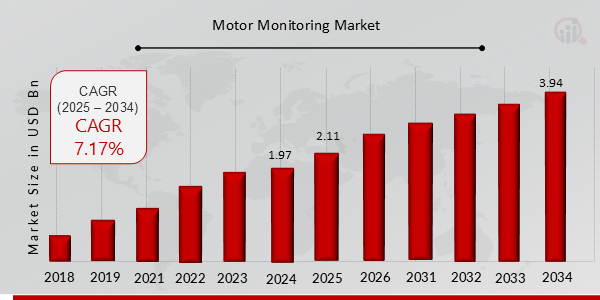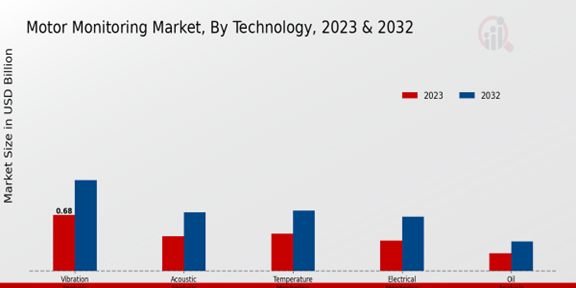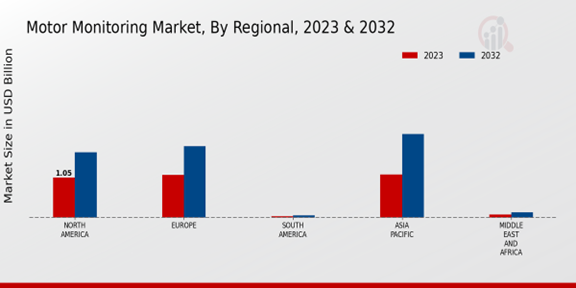Global Motor Monitoring Market Overview
As per MRFR analysis, the Motor Monitoring Market Size was estimated at 1.97 (USD Billion) in 2024. The Motor Monitoring Market Industry is expected to grow from 2.11 (USD Billion) in 2025 to 3.94 (USD Billion) till 2034, at a CAGR (growth rate) is expected to be around 7.17% during the forecast period (2025 - 2034).
Key Motor Monitoring Market Trends Highlighted
The Motor Monitoring Market is experiencing significant advancements, driven by the surge in digitalization and automation across industries. Key market drivers include the rising demand for predictive maintenance solutions to minimize downtime and optimize operational efficiency.
Growing concerns over energy consumption and sustainability are also fueling the adoption of motor monitoring systems, which provide real-time insights into energy usage and help identify energy-saving opportunities.
Recent market trends indicate a growing emphasis on wireless connectivity and cloud-based monitoring solutions. Wireless motor monitoring systems enable remote monitoring and data transmission, reducing the need for on-site inspections and maintenance.
Cloud-based platforms offer centralized data storage, analytics, and reporting capabilities, providing valuable insights for informed decision-making.
Additionally, the integration of artificial intelligence (AI) and machine learning (ML) technologies is enhancing the predictive capabilities of motor monitoring systems, enabling proactive maintenance and failure prevention.
Opportunities abound in the market for motor monitoring solutions that address specific industry requirements. For instance, the increasing adoption of electric vehicles (EVs) presents opportunities for customized motor monitoring systems tailored to the unique needs of EV powertrains.
Furthermore, the growing popularity of smart cities and intelligent buildings is creating demand for integrated motor monitoring solutions that can seamlessly connect with other IoT devices and systems.
 Source: Primary Research, Secondary Research, MRFR Database and Analyst Review
Motor Monitoring Market Drivers
Rising Demand for Predictive Maintenance
Source: Primary Research, Secondary Research, MRFR Database and Analyst Review
Motor Monitoring Market Drivers
Rising Demand for Predictive Maintenance
Predictive maintenance is becoming increasingly important in the Motor Monitoring Market as manufacturers strive to improve operational efficiency and reduce downtime. Motor monitoring systems provide real-time data on motor performance, enabling maintenance teams to identify potential problems before they cause costly failures.
This has led to a surge in demand for motor monitoring solutions, particularly in industries with critical production processes such as manufacturing, oil and gas, and power generation.
By leveraging motor monitoring systems, companies can proactively address issues, minimize unplanned downtime, and optimize maintenance schedules, resulting in significant cost savings and improved productivity.
Government Regulations and Standards
Stringent government regulations and industry standards are driving the adoption of motor monitoring systems. Governments worldwide are implementing regulations to enhance energy efficiency and reduce carbon emissions.
Motor monitoring systems play a crucial role in achieving these goals by providing insights into motor performance, enabling operators to optimize energy consumption and reduce their environmental footprint. Additionally, industry standards such as ISO 50001 and IEC 60034-17 require the implementation of energy management systems, which often include motor monitoring capabilities.
These regulations and standards are creating a favorable environment for the growth of the Motor Monitoring Market.
Advancements in Wireless Technology and IoT
Advancements in wireless technology and the Internet of Things (IoT) are transforming the Motor Monitoring Market. The proliferation of wireless sensors and connectivity solutions has enabled the development of remote monitoring systems that can collect data from motors in real time, regardless of their location.
This has eliminated the need for manual data collection and reduced the time and effort required for motor maintenance. Moreover, IoT platforms provide centralized data storage and analysis capabilities, allowing users to access insights and make informed decisions from anywhere.
These technological advancements are driving innovation and expanding the applications of motor monitoring systems.
Motor Monitoring Market Segment Insights
Motor Monitoring Market Technology Insights
The Motor Monitoring Market is segmented by technology into Vibration Analysis, Acoustic Analysis, Temperature Monitoring, Electrical Monitoring, and Oil Analysis. Vibration Analysis accounted for the largest share of the market in 2023 and is projected to continue to do so throughout the forecast period.
This is due to the increasing adoption of vibration analysis techniques for predictive maintenance applications. Vibration analysis can help to identify potential problems with motors early on, before they cause major damage. This can help to reduce downtime and maintenance costs.
Acoustic Analysis is another important technology segment. Acoustic analysis can be used to detect and diagnose problems with motors, such as bearing wear, gear mesh problems, and cavitation. This information can be used to schedule maintenance and repairs before they cause major problems.
Temperature Monitoring is another important technology segment. Temperature monitoring can be used to detect overheating motors. Overheating can be caused by a variety of factors, such as excessive friction, poor lubrication, or electrical problems. Temperature monitoring can help to prevent motor failures and fires.
Electrical Monitoring is also an important technology segment. Electrical monitoring can be used to detect electrical problems with motors, such as shorts, grounds, and overloads. This information can be used to schedule maintenance and repairs before they cause major problems.
Oil Analysis is another important technology segment. Oil analysis can be used to detect problems with the oil in motors. Oil analysis can help to identify problems such as contamination, wear, and oxidation. This growth is being driven by the increasing adoption of predictive maintenance techniques, the growing demand for energy efficiency, and the increasing complexity of motors.
 Source: Primary Research, Secondary Research, MRFR Database and Analyst Review
Motor Monitoring Market Application Insights
Source: Primary Research, Secondary Research, MRFR Database and Analyst Review
Motor Monitoring Market Application Insights
The Motor Monitoring Market is segmented by Application into Electric Motors, Induction Motors, Stepper Motors, DC Motors, and Servo Motors. Among these, the Electric Motors segment is expected to account for the largest revenue share in 2023, owing to the rising adoption of electric motors in various industries such as automotive, industrial, and energy.
Induction Motors are anticipated to be the fastest-growing segment during the forecast period, driven by their increasing adoption in industrial applications due to their high efficiency, reliability, and low maintenance requirements.
Motor Monitoring Market Vertical Insights
Among the various industry verticals, Oil Gas, Power Generation, Manufacturing, Automotive, and Aerospace Defense are prominent segments for the Motor Monitoring Market. The Oil Gas segment held a significant market share in 2023 and is projected to continue its dominance throughout the forecast period.
This growth is attributed to the increasing demand for real-time monitoring of motors in oil and gas exploration and production facilities to ensure operational efficiency and prevent costly downtime.
Additionally, the Power Generation segment is expected to witness steady growth due to the increasing adoption of renewable energy sources and the need for efficient power generation and distribution systems.
The Manufacturing segment is anticipated to contribute significantly to the Motor Monitoring Market revenue, driven by the growing automation and digitalization in manufacturing processes.
The Automotive and Aerospace Defense segments are also expected to experience notable growth due to the rising demand for advanced motor control and monitoring solutions in these industries, primarily focused on enhancing vehicle performance, safety, and reliability.
Motor Monitoring Market Deployment Model Insights
The Motor Monitoring Market is segmented based on the Deployment Model into On-Premises and Cloud-Based. The Cloud-Based segment is expected to dominate the market in the coming years due to its advantages such as scalability, flexibility, and cost-effectiveness.
This growth is attributed to the increasing adoption of cloud-based solutions by businesses of all sizes. The Motor Monitoring Market revenue for the On-Premises segment is expected to grow from USD 0.78 billion in 2023 to USD 1.49 billion by 2032, exhibiting a CAGR of 7.11%.
This growth is attributed to the need for on-premises solutions for critical applications that require high levels of security and control.
Motor Monitoring Market Sensor Type Insights
The Motor Monitoring Market is segmented by Sensor Type into Vibration Sensors, Acoustic Sensors, Temperature Sensors, Electrical Sensors, and Oil Sensors. Among these segments, Vibration Sensors hold the largest market share due to their ability to detect various motor faults, including unbalance, misalignment, bearing wear, and gear damage.
Vibration Sensors generate data that can be analyzed to identify the source of vibration and determine the severity of the fault. In 2024, the Vibration Sensors segment is expected to account for over 40% of the Motor Monitoring Market revenue.
Acoustic Sensors are also gaining popularity due to their ability to detect high-frequency sounds that can indicate motor problems. Temperature Sensors are used to monitor motor temperature and prevent overheating, while Electrical Sensors are used to detect electrical faults.
Oil Sensors are used to monitor oil condition and prevent contamination. The increasing adoption of predictive maintenance strategies is driving the growth of the Motor Monitoring Market as it enables early detection of motor faults and reduces downtime.
Motor Monitoring Market Regional Insights
The Motor Monitoring Market is expected to continue to grow in the coming years, with a significant portion of this growth coming from the regional markets. In terms of revenue, North America and Europe are expected to remain the largest regional markets for motor monitoring solutions, accounting for a combined share of over 60% in 2023.
This dominance is primarily driven by the presence of a large number of manufacturing facilities, stringent government regulations, and a growing focus on predictive maintenance in these regions. The APAC region is also expected to witness significant growth in the motor monitoring market, driven by rapid industrialization and increasing adoption of automation technologies.
South America and MEA are expected to experience steady growth in the motor monitoring market, albeit at a slower pace compared to other regions.
 Source: Primary Research, Secondary Research, MRFR Database and Analyst Review
Motor Monitoring Market Key Players and Competitive Insights
Source: Primary Research, Secondary Research, MRFR Database and Analyst Review
Motor Monitoring Market Key Players and Competitive Insights
Major players in the Motor Monitoring Market are constantly striving to gain a competitive edge by introducing innovative products and solutions. Leading Motor Monitoring Market players are focusing on developing advanced technologies that can provide real-time monitoring, predictive maintenance, and optimized performance.
Strategic partnerships and collaborations are also prevalent in the Motor Monitoring Market Competitive Landscape as companies seek to expand their market reach and enhance their product offerings.
A leading company in the Motor Monitoring Market is Emerson Electric Co., a technology and engineering company. Emerson provides comprehensive motor monitoring solutions, including vibration sensors, temperature sensors, and software for data analysis and visualization.
The company's expertise in industrial automation and control systems enables it to deliver integrated solutions that help customers optimize motor performance, reduce downtime, and improve energy efficiency. Emerson's commitment to innovation and customer satisfaction has positioned it as a strong competitor in the Motor Monitoring Market.
A prominent competitor in the Motor Monitoring Market is ABB Ltd., a leading provider of power and automation technologies. ABB offers a range of motor monitoring systems, including condition monitoring sensors, data acquisition units, and cloud-based analytics software.
The company's focus on digitalization and connectivity allows it to provide advanced solutions for remote monitoring, predictive maintenance, and asset optimization.
ABB's presence and strong partnerships with industry leaders enable it to cater to a diverse customer base across various industries. Through its commitment to innovation and customer-centric approach, ABB remains a formidable competitor in the Motor Monitoring Market.
Key Companies in the Motor Monitoring Market Include
- Honeywell
- General Electric
- Yokogawa Electric
- Baker Hughes
- Danaher
- Siemens
- Rockwell Automation
- Eaton
- Schneider Electric
- ABB
- Mitsubishi Electric
- Keyence
- Omron
- Emerson Electric
- National Instruments
Motor Monitoring Market Developments
The growth can be attributed to the increasing demand for predictive maintenance, the growing adoption of Industry 4.0 technologies, and the rising need for energy efficiency in industrial applications.
Recent developments and current affairs in the market include strategic partnerships, product innovations, and technological advancements:
- ABB and Microsoft Collaborate on AI-powered Motor Monitoring: ABB and Microsoft have partnered to develop AI-based motor monitoring solutions that leverage the Microsoft Azure IoT platform.
- Fluke Introduces New Motor Analyzer: Fluke Corporation has launched a new motor analyzer, the Fluke 438-II, which offers advanced diagnostic capabilities for electric motors.
- Emerson Acquires GE's Industrial Solutions Business: Emerson has acquired GE's Industrial Solutions business, expanding its portfolio of motor monitoring solutions and strengthening its position in the market.
These developments indicate the growing focus on innovation and collaboration in the motor monitoring market as companies seek to provide comprehensive solutions for predictive maintenance and energy optimization.
Motor Monitoring Market Segmentation Insights
Motor Monitoring Market Technology Outlook
- Vibration Analysis
- Acoustic Analysis
- Temperature Monitoring
- Electrical Monitoring
- Oil Analysis
Motor Monitoring Market Application Outlook
- Electric Motors
- Induction Motors
- Stepper Motors
- DC Motors
- Servo Motors
Motor Monitoring Market Vertical Outlook
- Oil Gas
- Power Generation
- Manufacturing
- Automotive
- Aerospace Defense
Motor Monitoring Market Deployment Model Outlook
Motor Monitoring Market Sensor Type Outlook
- Vibration Sensors
- Acoustic Sensors
- Temperature Sensors
- Electrical Sensors
- Oil Sensors
Motor Monitoring Market Regional Outlook
- North America
- Europe
- South America
- Asia Pacific
- Middle East and Africa
| Report Attribute/Metric |
Details |
|
Market Size 2024
|
1.97 (USD Billion)
|
|
Market Size 2025
|
2.11 (USD Billion)
|
|
Market Size 2034
|
3.94 (USD Billion)
|
|
Compound Annual Growth Rate (CAGR)
|
7.17% (2025 - 2034)
|
|
Report Coverage
|
Revenue Forecast, Competitive Landscape, Growth Factors, and Trends
|
|
Base Year
|
2024
|
|
Market Forecast Period
|
2025 - 2034
|
|
Historical Data
|
2019 - 2023
|
| Market Forecast Units |
USD Billion |
| Key Companies Profiled |
Honeywell, General Electric, Yokogawa Electric, Baker Hughes, Danaher, Siemens, Rockwell Automation, Eaton, Schneider Electric, ABB, Mitsubishi Electric, Keyence, Omron, Emerson Electric, National Instruments |
| Segments Covered |
Technology, Application, Industry Vertical, Deployment Model, Sensor Type, Regional |
| Key Market Opportunities |
Industrial Automation Predictive Maintenance Smart Grids Energy Efficiency Remote Monitoring |
| Key Market Dynamics |
Advancing technologies Predictive maintenance IoT integration Growing adoption of wireless sensors Increased focus on energy efficiency |
| Countries Covered |
North America, Europe, APAC, South America, MEA |
Frequently Asked Questions (FAQ) :
The Motor Monitoring Market was valued at approximately 2.11 billion USD in 2025.
The market is expected to exhibit a CAGR of 7.17% during the forecast period from 2025 to 2034.
The Motor Monitoring Market is predicted to reach a valuation of around 3.94 billion USD by 2034.
North America is anticipated to hold a significant market share due to the presence of major industry Players and advanced manufacturing capabilities.
Motor monitoring systems find application in various industries, including manufacturing, automotive, energy, and utilities, for predictive maintenance and performance optimization.
Notable competitors in the market include Emerson Electric Co., General Electric, ABB, Siemens, Rockwell Automation, and Schneider Electric.
Factors driving the growth of the market include increasing demand for energy efficiency, rising awareness of predictive maintenance, and advancements in sensor technologies.
Challenges faced by the market include data security concerns, integration complexities, and the need for skilled professionals for implementation and maintenance.
Emerging trends include the integration of artificial intelligence (AI) and machine learning (ML) for advanced analytics, the adoption of cloud-based monitoring solutions, and the development of wireless sensor technologies.
Industry 4.0 is anticipated to drive the demand for motor monitoring solutions by facilitating the adoption of smart manufacturing and predictive maintenance practices.


















